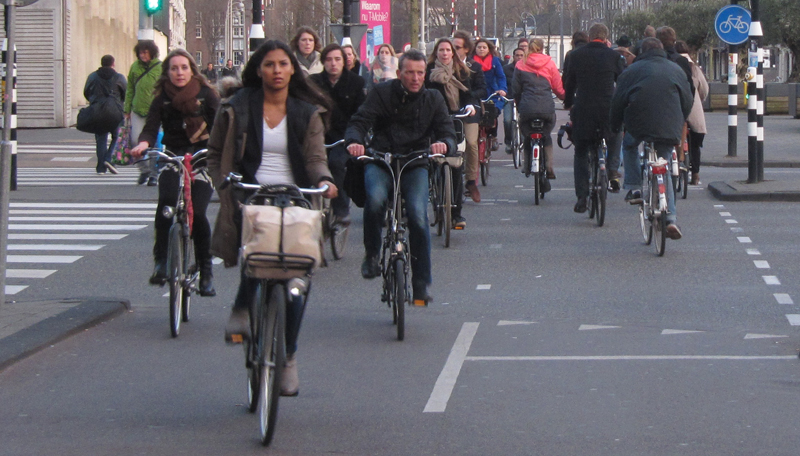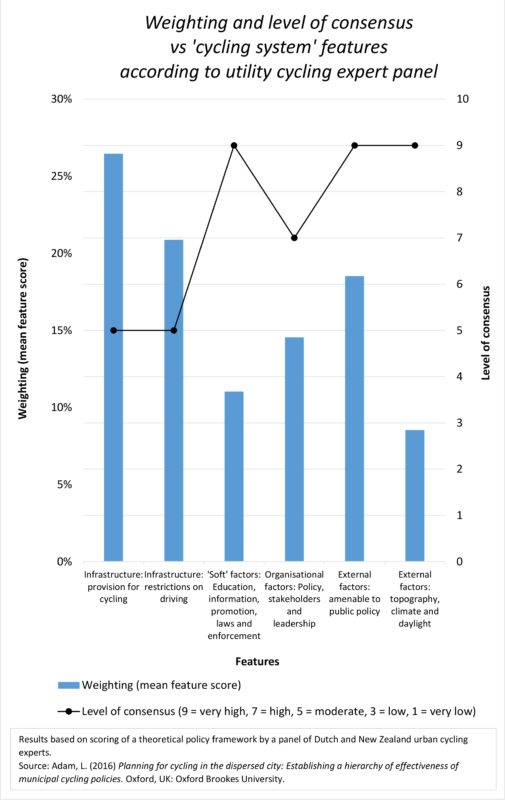Lukas Adam has recently finished a spatial planning degree at Oxford Brookes University in the UK, and is moving back to Auckland to put theory into practice. As he discovered in his dissertation research, planning for cycling in spread-out cities like Auckland is mostly about infrastructure, but you can’t ignore the context…
What’s the single biggest barrier to seeing more people on bikes in dispersed cities like Auckland? Safety (both real and perceived).
What is the most effective approach for improving safety? Building physical infrastructure.
Will ‘carrots’ alone be enough to encourage more people to bike? Probably not.
Can’t we just cut and paste what they have done in the Netherlands? Not really.
These were some of the messages gathered during a study I recently completed as part of my Master’s dissertation. For my research, I surveyed 28 cycling experts, based in New Zealand and the Netherlands. They came from backgrounds in policy, consultancy, advocacy and research, with a strong knowledge of cycling for transport (utility cycling, or everyday biking).
The graph below shows what the expert panel rated as most important for local bike policies, and the level of consensus that was reached. In other words, not just what they saw as crucial, but how strongly they agreed.
I also interviewed these connoisseurs, in an open-ended way, about the most effective means of improving conditions for cycling in a ‘dispersed city’ like Auckland. Here are some highlights from what they told me…
Safety is the biggest barrier to mainstream utility cycling, and physical infrastructure is fundamental in improving safety.
Improvements to infrastructure are crucial: from complete and consistent cycle networks at the city-wide level to best practice design of paths, lanes and intersections. It’s most productive to start with key links and destinations, segregating routes where traffic volumes and speeds necessitate, and calming neighbourhood streets to provide safe ‘nursery’ environments. This was summed up by a NZ policy professional:
“…fundamentally, if we want one percent of the market, we should just do what we did in the past. If we want to expand [everyday cycling] to the confident on-road cyclists then we … could get that other six or seven percent, but if we want to be really serious about cycling, we have got to look at all ages and abilities [which means] protected, separated infrastructure where possible. And in other situations traffic-calmed, bike boulevard-type treatments…”
Context has a strong influence – mostly those things within ‘our’ control
Cycling for transport – everyday cycling – happens in a cultural and physical context that strongly influences its prominence. Local conditions were often discussed during the interviews, and participants cautioned against a ‘cut and paste’ approach from one place to another.
Importantly, the panel strongly emphasised elements that can be influenced by some level of public policy above those elements that can’t be controlled. For example, population density, the mixing of land uses, the level of public transport services and the cost and difficulty of driver licensing – these sorts of factors were considered much more influential on whether people bike or not, when compared with factors like the hilliness or average temperatures of the city in question.
A Dutch practitioner touched on managing expectations in the context of layout of a dispersed city:
“…start with the network, but you have to be aware that the network doesn’t work if all the distances are very large – if you have a very low density and things are very remote.”
Political dimensions are all-important
The expert panel demonstrated strong awareness of the political dimension of cycling policy. For example, a NZ-based advocate provided this perspective:
“The barriers to more cycling, they tend to be financial, technical and political – and of those three, the one that occupies me the most are the political barriers.”
A prominent theme was the political nature of decisions relating to cycling, particularly re-allocations of road space. Another theme was the need for integration of cycling with other policy areas, as communicated by a Dutch researcher, who took a zoomed-out perspective on the cycling ‘system’:
“…you should never treat cycling in isolation…you should align it with other agendas….my priority intervention is to align the cycling agenda with the transit agenda and your urban agenda.”
It was broadly agreed that ‘carrots’ for cycling needed to be combined with ‘sticks’ discouraging car use, to make cycling more attractive relative to driving. It was recognised that measures that reduce traffic are also inherently effective in improving conditions for cycling.
We need to shape the cycling system around non-cyclists to encourage cultural diversity
The narrower demographic and culture of cycling in countries with low levels of cycling were frequently discussed. The consensus was that provision for cycling needs to be shaped around those who do not currently cycle as a means of transport, without discouraging those who already do. According to a Dutch practitioner:
“…if you want to provide for more… Dutch-style utility cycling, you would need to figure out how you accommodate for those strong and fearless people, but also for the other ones, within the context that is there, or what do you need to change in the context. I’m sure that some of [the strong and fearless] would be very worried to ride on cycle tracks because they want to ride on the road, they’ve always done that and that’s their thing.”
A NZ policy professional was aware of the need to encourage more diversity, but took a pragmatic approach to how to make a start:
“…in a city that doesn’t have a significantly connected network of protected cycleways, to encourage a broader spectrum of the population to cycle, until you get to the point where there is enough infrastructure to encourage…more women, more children, more older people onto bikes, then you need to target your encouragement towards the people who are most likely to ride… that is going to be people that are confident and brave enough to ride with motor traffic. So, in terms of the best use of your money for encouragement, that would be aiming it at generally younger men.”
Was there a noticeable difference in responses from NZ and Dutch participants?
Not really. There were some differences: for example, NZ participants placed more weight on infrastructure and organizational factors, while Dutch participants emphasised external factors. Overall though, these were not strong patterns, and the results are less significant due to the small sub-sample sizes.
What does this all mean for Auckland?
In my interpretation, the results of this study show that the approach applied in Auckland over recent years is generally heading in the right direction. There is an emphasis on providing segregated infrastructure, like the new Quay Street Cycleway, and the early focus is on linking the central city and inner suburbs.
In addition, public events and promotions such as Open Streets and the promotional spin-offs of landmark projects such as Te Ara I Whiti/Light Path are adding to the momentum. The wider perspective is also positive in terms of shaping the context. Public transport service improvements and (the intention of) changing planning controls to allow higher density and more land use mixing will improve conditions for active modes of transport.
There is still a long way to go before cycling is a mainstream mode in Auckland – but progress is being made. The development of cycling cities internationally shows that there are no quick fixes. First we shape the city, street by street, then it shapes us.
–Lukas Adam





